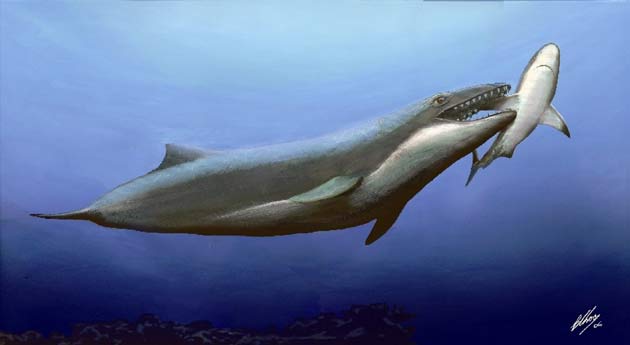Small Prehistoric Whale Was Vicious Hunter

Paleontologists have uncovered a 25-million-year-old whale fossil with a monstrous set of teeth and enormous eyes on the coast of Australia.
The discovery has researchers rethinking whales’ evolutionary history.
Scientists were surprised to find that the vicious-looking specimen is an ancestor of modern baleen whales, gentle giants of today’s seas. The fossil suggests a creature that grew to a little more than 11 feet with teeth about an inch-and-a-half long.
Baleen whales, which include the blue and humpback, feed by filtering plankton and small fish from seawater through hair-like fibers in their jaws. Their ferocious forebears, on the other hand, appear to have used their teeth to rip and chew meat, said lead researcher Erich Fitzgerald, a palaeobiologist at the Museum Victoria in Melbourne, Australia.
The details of the finding are published online in the Aug. 16 Proceedings of the Royal Society of London B.
Strange mix
Today there are two groups of whales: Mysticetes, or baleen whales, and odontocetes, or toothed whales such as orcas and dolphins. Some modern baleens do have teeth, but they use them for filtering rather than biting. Scientists believe the two groups diverged about 35 million years ago.
Sign up for the Live Science daily newsletter now
Get the world’s most fascinating discoveries delivered straight to your inbox.
The fossil’s skull shape tells scientists this is undoubtedly a baleen whale, Fitzgerald said.
In many ways it is markedly different from its modern counterparts though. The fossil whale has a more varied set of teeth and extremely long incisors, as you might expect to see on a cat or other terrestrial carnivorous animal, said Alton C. Dooley, Jr., Assistant Curator of Paleontology at the Virginia Museum of Natural History.
The animal's huge eyes, which scientists associate with sharp underwater vision, are also adaptive for hunting. The whales probably couldn’t produce ultrasonic signals for echolocation or sonar though, as some modern whales can to locate prey.
Rethinking evolution
It now appears whale evolution was more complex than a simple split 35 million years ago. Not only does the fossil add a branch to the family tree, it also fills a time gap for researchers.
“The Oligocene period, which this fossil is from, was a fascinating time for whale evolution, due possibly to changes in ocean circulation, and a lot of marine groups were diversifying rapidly,” said Dooley, who was not involved in the finding.
Fossils dating back that far are rare though, particularly in Australia.
While the discovery now has the scientific community abuzz, it took years for researchers to realize its significance.
In 1997, a teenage surfer named Staumn Hunter found the fossil in a limestone rock at Jan Juc Beach and researchers named it Janjucetus hunderi in his honor. After they brought it back to the lab though, it languished there until Fitzgerald took another look a few years later.
Now the only question is what else it might reveal about prehistoric life.
“It’s a spectacular specimen, beautifully preserved, and I’m curious to see over the next few months what will develop from it, everyone will have to weigh in and decide exactly what this means,” Dooley told Live Science.









